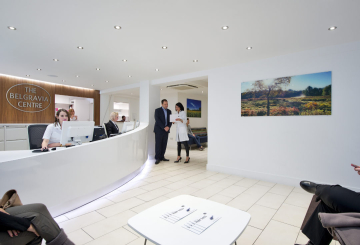Stem Cell Hair Loss Treatments May Be Available by 2020
The race to bring stem-cell based treatments for hair loss to market is heating up, with several organisations all promising revolutionary new treatments in the coming years.
As predicted by Belgravia Centre MD Jonny Harris in an article in the Daily Mail last summer, hair loss therapies based around stem-cell technologies look set to be one of the most important new treatments available to men with the widespread genetic condition Male Pattern Baldness. They could also prove effective for some other hair loss conditions, including Female Pattern Hair Loss and, most significantly, Scarring or Cicatricial Alopecia which would be a major breakthrough given this can rarely be treated at present.
We have not included Alopecia Areata research in this particular piece as, whilst that area of study appears to be having its own renaissance with many potential new treatments being discovered and tested, there is no news on when these may become available yet.
 What are they, how do they work, and when are they coming?
What are they, how do they work, and when are they coming?
To answer the first question, the simplest explanation is that most stem cell therapies are based around growing new hair follicles in a lab, often through a technique which allows existing follicles to be replicated. New follicles capable of growing hair are typically engineered after doctors take a small skin sample from the patient’s scalp then, once new follicles have been harvested, implant them back into the patient’s scalp.
It is broadly similar to a traditional hair transplant procedure only instead of removing a number of hairs from a donor area of the head unaffected by hairloss, a smaller number of follicles are taken then replicated to fulfill the necessary quota. Each tiny follicle is delicately implanted where it is needed in cases of MPB that would typically be to fill in a thinning crown or to even out a receding hairline as genetic hair loss only affects the top of the scalp.
Clinically-proven male hair loss treatments can already help to reduce the production of a testosterone by-product named DHT: it is this that ultimately leads to hair falling out. They can also accelerate hair growth, leading to a stabilisation of shedding and regrowth for many affected men. However, whilst the MHRA and FDA approved hair loss treatments available right now can produce significant results, they will not usually work in cases of true baldness; once the scalp skin becomes smooth and shiny it indicates that the follicles have been destroyed. In this instance they are no longer open to stimulation so pharmaceutical and even sometimes surgical methods are unworkable.
It is men with this level of severe balding and people whose hair has been lost to scarring that could benefit most from follicle replication advances, and it does feel like medical science is fast approaching the point at which stem-cell treatments like this will become a viable option. Even prestigious business magazine, Forbes has picked up on the story, stating that “giant strides to prevent and cure baldness are being made in medical labs around the world.”
Round-up of what they key players are up to:
Riken
Possible applications:
Male Pattern Baldness, Female Pattern Hair loss, Cicatricial Alopecia
This government-affiliated Japanese research company is working to perfect a technique where they can grow skin in a lab. Their approach has been hailed as one of the most advanced as they are able to grow “complete” skin, including sweat glands and hair follicles. They hit the headlines earlier this year when they were able to implant hair follicles onto bald mice; most recently they have partnered up with Japanese tech firm Kyocera who hope to help Riken take their technologies to market.
Estimated availability: 2020 for human clinical trials.
The Sanford Burnham Prebys Medical Discovery Institute
Possible applications:
Male Pattern Baldness
This recently-renamed (following a $100m donation) California-based organisation have been able to grow hair in mice using human stem cells. In January 2015 they reported that they had used human pluripotent stem cells to create the hair, and said that their research represented the first step toward the development of a cell-based treatment for people with hair loss. “Our next step is to transplant human dermal papilla cells derived from human pluripotent stem cells back into human subjects,” said Alexey Terskikh, associate professor at the institute’s Development, Aging and Regeneration programme. “We are currently seeking partnerships to implement this final step.”
Estimated availability: unknown no further updates have been issued since news of their initial success.
Shiseido and RepliCel
Possible applications:
Male Pattern Baldness, Female Pattern Hair Loss
These two companies partnered up only recently and instantly attracted media attention when it emerged that they were suggesting they could have a hair loss cure commercially available by 2018. RepliCel, based in Vancouver, are a leading light in stem cell research with regards its possible application for people with hair loss. Several years ago, their CEO David Hall said: “On the technical level, we’re not asking these cells to do anything other than what they naturally do, or be anything more than they are. We’re not differentiating, genetically modifying, or manipulating these cells in any way.” Japanese brand Shiseido have a wide-range of cosmetic and beauty products and, it can be assumed, will be the public face of the new treatment.
Estimated availability: 2018 but don't get your hopes up! This date has already been pushed back a number of times and it seems extremely unlikely such a large step could be taken in the next 2 years.
There are many other research institutes who have hit the headlines over the last decade with regards progress they had made in the field of stem cell research as it pertains to hair loss, but many of them appear to have gone quiet. One possibility is that their work ran into insurmountable complications, though another possibly more likely reason for their lack of news is that funding may have become an issue.
Funding only tends to be readily available when investors can see a prize at the end of the tunnel. Given that Male Pattern Baldness and Female Hair Loss can both already be successfully treated using existing, medically-proven hair loss treatment methods, this may, perhaps, have proven something of a barrier to the development of potential new treatments that would need investments in the tens if not hundreds of millions to bring to market.

The Belgravia Centre
The Belgravia Centre is a world-renowned group of a hair loss clinic in Central London, UK. If you are worried about hair loss you can arrange a free consultation with a hair loss expert or complete our Online Consultation from anywhere in the world for home-use treatment.
View our Hair Loss Success Stories, which includes the world's largest gallery of hair growth photos and demonstrates the level of success that so many of Belgravia's patients achieve.
